- Itoigawa Seaside Valley Ski Area
- Bokkajaya Restaurant
- Salt Trail Hot Springs - Hotel White Cliff

Road & Geosite Conditions
Partially Accessible

- Number
- Area
- 1. Ichiburi Geosite
- 2. Oyashirazu Geosite
- 3. Omi Coast Geosite
- 4. Omigawa Jade Gorge Geosite
- 5. Imai Geosite
- 6. Itoigawa-Shizuoka Tectonic Line and Salt Trail(North) Geosite
- 7. Maikomidaira Geosite
- 8. Hashidate Gold Mine Geosite
- 9. Kotakigawa Jade Gorge Geosite
- 10. Tsugami Shindo Geosite
- 11. Himekawa Gorge Via Oito Line Geosite
- 12. Itoigawa-Shizuoka Tectonic Line and Salt Trail(South) Geosite
- 13. Himekawa Gorge Geosite
- 14. Renge Geosite
- 15. Itoigawa Coast Geosite
- 16. Miyama Park and Museums Geosite
- 17. Tsukimizunoike Geosite
- 18. Umidani Gorge Geosite
- 19. Amakazariyama Geosite
- 20. Yakeyama Geosite
- 21. Benten-iwa Geosite
- 22. Shindosan Geosite
- 23. Gongendake Geosite
- 24. Tsutsuishi Hamatokuai Geosite
- Jade
- 1. Ichiburi Geosite
- 2. Oyashirazu Geosite
- 3. Omi Coast Geosite
- 4. Omigawa Jade Gorge Geosite
- 9. Kotakigawa Jade Gorge Geosite
- 15. Itoigawa Coast Geosite
- 16. Miyama Park and Museums Geosite
- Fossa Magna
- 5. Imai Geosite
- Itoigawa-Shizuoka Tectonic Line and Salt Trail(North) Geosite
- 11. Himekawa Gorge Via Oito Line Geosite
- 12. Itoigawa-Shizuoka Tectonic Line and Salt Trail(South) Geosite
- 13. Himekawa Gorge Geosite
- 17. Tsukimizunoike Geosite
- 21. Benten-iwa Geosite
- 22. Shindosan Geosite
- 24. Tsutsuishi Hamatokuai Geosite
- Mountainous areas
- 7. Maikomidaira Geosite
- 8. Hashidate Gold Mine Geosite
- 10. Tsugami Shindo
- 14. Renge Geosite
- 18. Umidani Gorge Geosite
- 19. Amakazariyama Geosite
- 20. Yakeyama Geosite
- 23. Gongendake Geosite

Along the Salt Trail are a number of sights, including the Sugi-no-To Great Cedar, Shiroike Pond, and the Salt Trail Museum. After visiting these, the Shionomichi Onsen Hot Spring is waiting for to wash away your sweat and fatigue.
Dividing the Japanese Islands in twain, the Itoigawa-Shizuoka Tectonic Line forms the western border of the Fossa Magna. This fault mostly follows the Himekawa River, but the section between Nechi and Kita-Otari (in Nagano Prefecture) travels through the mountains to the east. Through landslides and other geological processes, the area around the fault line formed into a gentle depression cutting through the mountains.
The Salt Trail runs along this fault, through these lowlands, avoiding the steep slopes of the mountains and the dangerous terrain and swift currents of the Himekawa River. This trail was used during from ancient times as a trade route between Niigata Prefecture (then called Echigo Province) with Nagano Prefecture (then called Shinano Province). From Echigo, fish, seaweed, and products traded by sea routes were carried inland to Shinano which in return sent tobacco, grains, and similar products. The most important product carried along this route, though, was salt, harvested along the coast, sea salt was carried inland for processing and distribution. In the days before refrigerated storage, salt was essential for the preservation of food and so the Salt Trail was like a lifeline for the people of the inland provinces. It is this reason why, even during times of civil war and bitter fighting between the provinces, this trade route was never closed or blockaded.
Enjoy walking this gently sloping forest trail. The leaves underfoot provide a soft, comfortable surface to walk upon, while the trees overhead shelter travelers from the wind, rain, and snow. Observe the scenic rural landscape along the trail and encounter a variety of wildlife, including a number of endangered species of dragonflies. Taste a bit of local culture at the Bokkajaya Tea House. And relax in the hot spring baths at Shionomichi Onsen.
 Salt Trail
Salt Trail
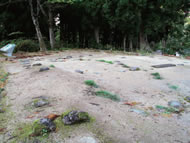
Remains of an inn along the Salt Trail
The Salt Trail was carved centuries ago and roughly follows the Itoigawa-Shizuoka Tectonic Line, where the land slopes gently and forms a natural depressions passing through the mountains. From ancient times until the early 20th century, this road was used to transport salt and other marine products inland to Nagano, to be traded for tobacco as well as rice and other grains.
At this geosite you can explore the Salt Trail yourself and pass by the former sites of a number of barrier gates, teahouses, and inns where the porters and traders once visited in ages past.
 Shiroike Pond
Shiroike Pond
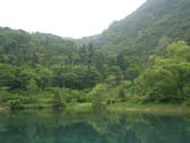
Shiroike Pond is believed to have been formed as the result of landslides around the Itoigawa-Shizuoka Tectonic Line. Snow melting in the spring causes the pond to swell and turn white from its disturbed clay bed, from whence it derives its name, which means "White Pond" in Japanese.
Once the site of inns and other resthouses along the Salt Trail, this pond now serves as a reservoir for rice field irrigation. A park around the pond offers hikers and picnickers alike a beautiful place to relax and enjoy the scenery.
 Mt. Tokurayama
Mt. Tokurayama
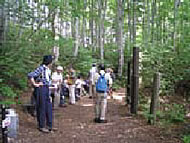
Mt. Tokurayama Climbing Trail
While at 976m it is a fairly small mountain, the view from the peak of Mt. Tokurayama is not to be missed, offering a 360 degree panorama of nearby Mt. Amakazariyama, the Northern Alps, and the Sea of Japan. On clear days you can even see as far as Noto Peninsula or Sado Island!
The trail up the mountain is well maintained and passes through a beautiful beech forest, well-protected from the elements. From Shiroike Pond it is only about 70 minutes to the peak, making it a perfect climb for beginners , but the view from the top makes it worthwhile even for the expert climber.
 Interbeds of sandstone and mudstone
Interbeds of sandstone and mudstone

The geological strata in this area were formed underneath a sea about 10 million years ago. Alternating layers of sand and mud deposited upon the seabed eventually solidified into stone, forming the beautifully striated cliffsides visible today. Along these cliffs you can also see a fault lines as well as lava and magma formations, all examples of the geological processes that formed this region.
 The Salt Trail Museum
The Salt Trail Museum
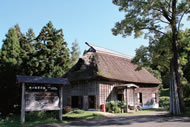
This museum, located inside a repurposed farmhouse, houses a collection of over 700 artifacts from the days of the Salt Trail, including a variety of tools used by the bokka (porters) and ushikata (oxmen) who transported goods up and down the road. The artifacts housed here have been designated national cultural properties.
 Bokkajaya Tea House & Shionomichi Hot Spring
Bokkajaya Tea House & Shionomichi Hot Spring

Shionomichi Hot Spring
This is the heart of Nechi and the Intormation Centre for the Salt Trail and the region. Offering local cuisine, handicrafts, and cultural workshops, these facilities are well-loved by hikers, skiers, and tourists of all ages and backgrounds. The restaurant here is quite popular with visitors and locals alike and the hot spring bath is the perfect way to relax after a long day of exploring everything the Nechi valley has to offer.
Ennen Performance of Nechi-Yamadera Temple - Otetekomai Dance
Ennen is an extremely ancient type of performance which combines music, dance, and theatre. It is believed to be among the first performing arts in Japan, from which the more well-known noh and later kabuki theatre formats developed.
The Ennen of Nechi-Yamadera Temple is the only established ennen performance in Niigata Prefecture, performed every September 1st. It is believed to have been brought to the region from Kyoto about 500 years ago.
Although the meanings and stories behind the dances performed are lost to time, the performance has become a nationally designated intangible cultural heritage and is of academic interest to anthropologists and folklorists.
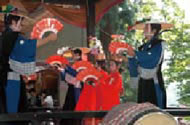
Seaside Valley Ski Resort
Itoigawa's Seaside Valley Ski Resort offers 6 slopes and a number of courses for skiers of all experience levels. Enjoy views of Mt. Amakzariyama, the Northern Alps, and the Sea of Japan while racing down the white slopes of the Kubiki Mountains.

Route to Itoigawa-Shizuoka Tectonic Line and Salt Trail (South)
Destination:



